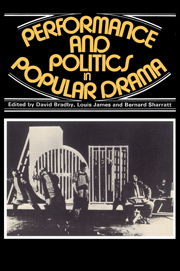 Performance and Politics in Popular Drama
Performance and Politics in Popular Drama Book contents
- Frontmatter
- Contents
- List of contributors
- Preface
- Acknowledgements
- PART ONE Spectacle, performance and audience in nineteenth-century theatre
- Introduction
- Was Jerrold's Black Ey'd Susan more popular than Wordsworth's Lucy?
- Word and image in Pixérécourt's melodramas: the dramaturgy of the strip-cartoon
- Joseph Bouchardy: a melodramatist and his public
- The music of melodrama
- Popular theatre in Victorian Birmingham
- Water drama
- Equestrian drama and the circus
- Theatre of war: the Crimea on the London stage 1854–5
- Popular drama and the mummers' play
- PART TWO Politics and performance in twentieth-century drama and film
- PART THREE Problems and prospects
- Appendix: Tempo, Tempo
- Select bibliography
- General index
- Index of titles of plays, films, sketches
- Index of theatres, theatre companies and groups
Word and image in Pixérécourt's melodramas: the dramaturgy of the strip-cartoon
Published online by Cambridge University Press: 08 March 2010
- Frontmatter
- Contents
- List of contributors
- Preface
- Acknowledgements
- PART ONE Spectacle, performance and audience in nineteenth-century theatre
- Introduction
- Was Jerrold's Black Ey'd Susan more popular than Wordsworth's Lucy?
- Word and image in Pixérécourt's melodramas: the dramaturgy of the strip-cartoon
- Joseph Bouchardy: a melodramatist and his public
- The music of melodrama
- Popular theatre in Victorian Birmingham
- Water drama
- Equestrian drama and the circus
- Theatre of war: the Crimea on the London stage 1854–5
- Popular drama and the mummers' play
- PART TWO Politics and performance in twentieth-century drama and film
- PART THREE Problems and prospects
- Appendix: Tempo, Tempo
- Select bibliography
- General index
- Index of titles of plays, films, sketches
- Index of theatres, theatre companies and groups
Summary
What importance should we give to Pixérécourt's well-known statement, ‘I am writing for those who cannot read’? How literally should it be taken, and what are its implications for anyone inquiring into the nature of popular drama in early-nineteenth-century France? It could reasonably be argued that the degree of literacy of a theatre audience is irrelevant to the production of a spectacle designed to be seen and heard; and no doubt those who approve of the gradual emancipation of European drama from what they regard as excessively literary influences would applaud Pixérécourt's statement as heralding a move away from text towards spectacle. On the other hand, it is possible to interpret the ‘popular’ character of his melodramas in a different light, and to see this genre, for all its visual spectacle and despite its apparent anti-literary tendency, as one still dependent on literary traditions, one in which the spoken word is still used in a recognisably ‘literary’ manner, even if this manner is generally simplified and often debased. I propose in this paper to examine the relationship between spoken word and visual image in a number of representative plays; and I shall attempt to justify the phrase ‘the dramaturgy of the strip-cartoon’.
The emergence of melodrama in the years around 1800 is best explained by the fusion of two developments, one popular and one literary, in the drama of the preceding generation. The importance of the pantomime, or musical mime-play, to which enterprising directors of independent theatres resorted in order to circumvent the monopoly of spoken and sung drama held by the official houses, has been stressed by Pitou and others.
- Type
- Chapter
- Information
- Performance and Politics in Popular DramaAspects of Popular Entertainment in Theatre, Film and Television, 1800–1976, pp. 17 - 32Publisher: Cambridge University PressPrint publication year: 1980
- 2
- Cited by


